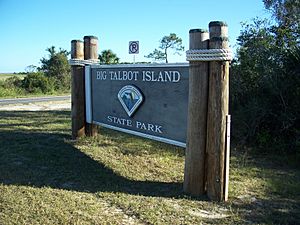Big Talbot Island State Park facts for kids
Quick facts for kids Big Talbot Island State Park |
|
|---|---|
|
IUCN Category IV (Habitat/Species Management Area)
|
|
| Location | Duval County, Florida, USA |
| Nearest city | Jacksonville, Florida |
| Established | 1982 |
| Governing body | Florida Department of Environmental Protection |
Big Talbot Island State Park is a cool state park in Florida, USA. It's found on Big Talbot Island, which is a special barrier island right by the coast. This island is about 20 miles east of downtown Jacksonville. It's also right next to Little Talbot Island State Park.
This park is a wonderful place to explore nature. You can learn about plants and animals, watch birds, or take amazing photos. There are many fun activities here. You can go hiking, bicycling, fishing, or boating. Canoeing, kayaking, and picnicking are also popular. The park has picnic areas, nature trails, a fishing pier, and beaches. It's open every day from 8:00 AM until sunset.
The beaches at Big Talbot Island are very unique in Florida. They have special rock-like soil deposits under the sand. When these formations show up in the shallow water, they create homes for crabs, oysters, and other tide pool creatures. The sand and rocks on Blackrock Beach are darker than other beaches. You can get to the beach from the park entrance. Or you can use the parking area for the Blackrock Trail. At the end of the Blackrock Trail is Boneyard Beach. Here, you'll see old, bleached tree trunks along the shore. Boneyard Beach is great for photographers, but not for swimming.
Big Talbot and Little Talbot are two of the few natural islands left in Florida. Long ago, a Native American group called the Timucua lived here. Later, countries like France, England, and Spain claimed the islands. In 1735, General James Oglethorpe named the islands after Charles Talbot. He was a very important person in Great Britain. These islands, along with the nearby Timucuan Ecological and Historic Preserve, have many different types of natural areas. They are full of amazing wildlife.
Contents
Exploring Nature at Big Talbot Island
Big Talbot Island State Park protects many different natural places. These include sandy beaches, coastal scrub lands, and shady hammock forests. You can also find estuaries (where rivers meet the sea) and tidal marshes. Some parts of the salt marsh around Big Talbot Island are also part of the Machaba Balu Preserve.
Plants You Might See
The park is home to many kinds of plants. You'll see tall southern live oaks, hollys, and magnolias. There are also hickories and tall cabbage palmettos. On the beaches, you'll find sea oats. And in other areas, you might spot saw palmettos.
Animals You Might Spot
This state park is full of amazing animals! Keep an eye out for alligators and sea turtles. You might also see Florida gopher tortoises. Gentle West Indian manatees live in the water. On land, you could spot white-tailed deer, river otters, and marsh rabbits. Other animals include raccoons, bobcats, and foxes. Look up to see birds like pileated woodpeckers, northern cardinals, and even bald eagles. You might also hear barred owls or see fast peregrine falcons. Colorful painted buntings and Florida scrub jays also live here.
Images for kids
-
Railroad Vine - Big Talbot Island Beach morning glory










